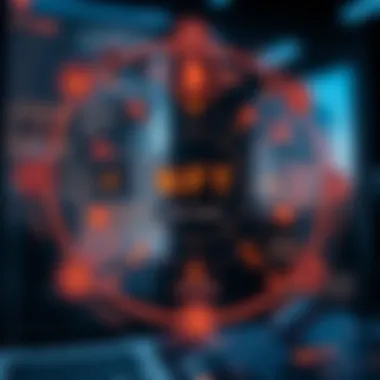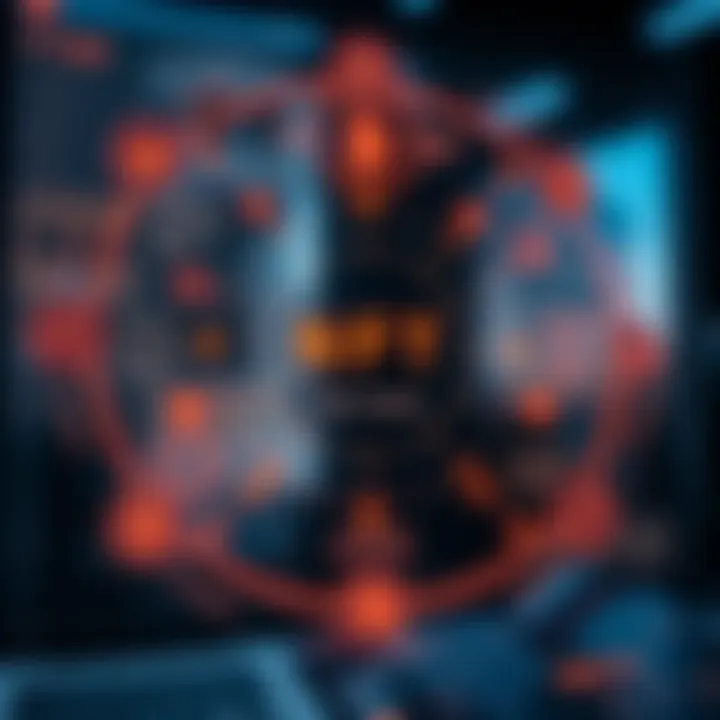Understanding Blockchain and NFTs: A Comprehensive Guide


Intro
As the digital landscape evolves, the terms blockchain and non-fungible tokens (NFTs) are increasingly woven into conversations about the future of investment and ownership. The interplay between these concepts not only offers a peek into a new era of digital assets but also raises significant questions about their implications for various sectors ranging from art to real estate.
At their core, blockchains are decentralized ledgers that provide transparency and security, allowing data to be stored in an immutable way. They underpin cryptocurrencies and are equally crucial for NFTs, which are unique digital assets that represent ownership of items in a digital format. Understanding this soul-link between these two technologies is essential for navigatiing today’s fast-paced investment landscape.
This comprehensive exploration will scrutinize the myriad facets of blockchain and NFTs, diving into their characteristics, functionalities, practical applications, and the hurdles along the way. As we progress through this guide, readers will uncover valuable insights necessary for making informed decisions in this exciting yet intricate domain.
Investment Terminology
Key Definitions
Before delving deeper into the discussion, it’s pivotal to clarify some terms that frequently pop up in this sphere. Understanding these definitions helps ensure clarity as you explore the broader context.
- Blockchain: A distributed digital ledger that securely records transactions across many computers.
- NFT (Non-Fungible Token): A unique digital asset that represents ownership of a specific item or piece of content, validated through blockchain technology.
- Smart Contracts: Self-executing contracts with the terms of the agreement directly written into code, often used in NFT transactions.
Grasping these basic definitions sets the foundation necessary for understanding the unique properties of NFTs and their growing prominence in the digital economy.
Commonly Used Terms
Apart from the basic definitions, a few other buzzwords can often crop up in discussions about NFTs and blockchain:
- Minting: The process of creating a new NFT and registering it on the blockchain.
- Wallet: A digital storage solution that allows users to keep their cryptocurrencies and NFTs securely.
- Gas Fees: Transaction fees required to conduct operations on the blockchain, which can fluctuate based on network demand.
- Interoperability: The ability of different blockchain networks to communicate and work together, crucial for the future of NFTs.
Familiarity with this terminology will not only boost your confidence but also enhance your ability to engage in broader discussions about investments in NFTs.
Expert Advice
Investment Strategies
Diving into NFTs as an investment vehicle comes with its excitement and risks. Here are some strategies to consider:
- Research Familiarity: Gain a solid understanding of the projects behind the NFTs you're interested in; it's essential to know the creators’ track record and the community's engagement.
- Diversification: As with any investment, don't put all your eggs in one basket. Spread your investments across various NFTs and possibly even different categories in the wider blockchain space.
- Buy Art and Culture: Many NFTs stem from the world of art and gaming, where emotional value can also play a role in perceived worth. Investing in these can be lucrative if you choose the right pieces.
Risk Management Tips
Investing in NFTs isn’t without its risks, hence having a strategy in place is vital. Consider these tips:
- Set a Budget: Determine what you can afford to lose; this isn’t just about potential gain but also about protecting your assets.
- Stay Updated: The NFT market is rapid-fire. Follow forums and platforms where timely news about upcoming drops and market trends are discussed, such as Reddit or Twitter.
- Evaluate Liquidity: Understand that not all NFTs can be swiftly resold. Assess the market demand for your chosen tokens to ensure they won’t trap your funds for long periods.
By integrating these strategies and tips, aspiring investors can embark on their journeys in the NFT space well-prepared to face the challenges it entails.
Prelude to Blockchain Technology
Understanding the foundations of blockchain technology is paramount for grasping the world of NFTs. This section provides a roadmap to the significant concepts that underline blockchain, how it operates, and its pivotal role in the realm of non-fungible tokens. As we dive into blockchain, consider this a stepping stone that will eventually lead us to the complexities of NFTs. Comprehending these basic principles reveals the potential advantages and challenges that lie ahead for investors and enthusiasts in this fast-evolving landscape.
Basic Concepts of Blockchain
At the very core, blockchain is a digital ledger. Imagine a really well-organized notebook where every page details transactions that are securely recorded. Each transaction becomes a "block" that's linked or "chained" to the previous one. Hence, it forms a sequence that's transparent and verifiable by anyone with access— no smoke and mirrors here. Importantly, blockchain does not rely on a single entity for management, which leads us to a crucial aspect: decentralization.
Here are essential features of blockchain to be aware of:
- Immutability: Once data is entered into the blockchain, it's nearly impossible to alter it without detection.
- Transparency: Anyone can access the blockchain to verify transactions, fostering trust among users.
- Security: With advanced cryptography, blockchain boasts a fortress-like protection against fraud and data breaches.
These characteristics set the stage for why blockchain is a game-changer in various sectors, not just finance, but also in supply chains, healthcare, and particularly in the area of NFTs.
Decentralization and its Importance
Decentralization is the lifeblood of blockchain technology. Traditionally, data management systems are governed by central authorities—think banks or governments. This centralization can lead to inefficiencies or even abuses of power. Blockchain flips that script; rather than a singular controller, the authority lies within a distributed network of peers. This means that decisions aren't made behind closed doors, fostering an environment that's both inclusive and resilient.
The importance of decentralization can't be understated:
- Increased Trust: Users don’t need to place their faith in a single entity. Rather, they rely on collective validation from a multitude of sources.
- Reduced Risk: With no single point of failure, blockchain is less vulnerable to systemic attacks.
- Empowerment: Individuals have greater control over their data and assets, enabling a level of independence that didn’t previously exist.
For investors, this decentralization translates into potentially lower risks and opens up myriad possibilities for innovation.


How Blockchain Works
To grasp how blockchain functions, picture a community potluck dinner. Each guest brings a dish, and just as in the potluck, every participant contributes a piece of information that gets added to the larger meal. In blockchain terms, each transaction is akin to a dish added to the communal table.
Here’s how it breaks down:
- Transaction Initiation: Someone initiates a transaction. This could be a sale, an exchange of information, or the transfer of assets.
- Validation: Before this transaction can be officially recorded, it has to be confirmed by others in the network through a consensus mechanism. This is where the magic happens—the community checks and verifies the authenticity of the transaction.
- Recording: Once validated, the transaction gets bundled into a block and added to the existing chain. Each block contains a timestamp and all the details of the transaction.
- Distribution: This updated version of the blockchain is then disseminated to all network participants, ensuring that everyone has an identical copy of the ledger.
- Completion: The transaction is complete, and the next one can commence, continuing this cyclical process.
Understanding these workings is fundamental as they lay the groundwork for what will be discussed about NFTs. All the unique properties of these tokens are springing from the same elements that define blockchain technology. Armed with this knowledge, readers can appreciate the power and potential that comes with NFTs—an investment that blossoms from the robust roots of blockchain.
Defining Non-Fungible Tokens (NFTs)
In the world of digital assets, Non-Fungible Tokens (NFTs) have become a topic of significant importance. Understanding NFTs is crucial for grasping how they fit into the larger digital economy. Unlike traditional currencies or even cryptocurrencies like Bitcoin, which are interchangeable and hence fungible, NFTs represent unique items or assets. This unique status brings to light a variety of benefits, considerations, and implications that are pivotal in today's investment landscape.
Characteristics of NFTs
NFTs are distinguished by their unique characteristics. Unlike fungible tokens that can be exchanged for one another, an NFT is one of a kind. This uniqueness stems from several features:
- Indivisibility: NFTs cannot be divided into smaller units, making them a whole item. You cannot own half of a piece of digital art like you might with a share of stock.
- Provenance: Each NFT has a unique history or chain of ownership, verified on the blockchain. This is particularly important for creators and collectors as it establishes authenticity.
- Smart Contract Integration: Most NFTs are built on smart contracts, particularly those based on Ethereum. These contracts enforce rules and conditions regarding ownership, transfer, and permissions.
- Metadata: NFTs contain metadata that provides detailed information about the asset, such as the creator, ownership history, and other attributes. This metadata is stored securely on the blockchain, further assuring authenticity and value.
These features make NFTs particularly relevant in various sectors, adding value that is not present in other digital or physical assets.
Differences Between Fungible and Non-Fungible Tokens
In order to truly appreciate the significance of NFTs, it's essential to differentiate them from their fungible counterparts. Here’s a closer look at the distinctions:
- Interchangeability: Fungible tokens, such as Bitcoin or Ether, can be exchanged easily with one another. You can trade one Bitcoin for another without affecting value or utility. On the flip side, an NFT's value lies in its uniqueness, meaning that one NFT cannot be outright exchanged for another, even within the same collection.
- Value Assessment: The value of fungible tokens usually fluctuates based on market demand and supply dynamics. However, NFT values are often affected by emotional and cultural factors, making valuation subjective. A piece of digital artwork might be worth millions to some, while others might not see its value at all, demonstrating the diverging valuation mechanisms.
- Ownership Rights: When purchasing a fungible token, ownership is straightforward and easily transferable. NFTs come with specific rights and limitations that can vary based on the smart contract governing the token. This complexity necessitates a deeper understanding for buyers and sellers.
"NFTs are reshaping the understanding of ownership and value in the digital space."
To wrap it up, grasping the concept of Non-Fungible Tokens entails more than just the knowledge of what they are. It involves understanding their unique properties, their differences from fungible tokens, and the implications of these characteristics in the broader context of digital assets. As this field continues to evolve, it's imperative for individuals, especially financial enthusiasts and individual investors, to stay informed about how these tokens might shape the future of investment.
The Technical Framework of NFTs
The technical framework of non-fungible tokens (NFTs) is the backbone that allows these digital assets to function as unique entities within the blockchain ecosystem. Understanding this framework is vital for anyone looking to dive into the world of NFTs, whether for investment purposes, creation, or simply gaining knowledge. The importance lies not just in the technology itself, but also in how it influences value, ownership, and the interaction between digital and physical realms.
Smart Contracts and NFTs
Smart contracts are self-executing contracts with the terms of the agreement directly written into code. They run on blockchain platforms and facilitate, verify, or enforce the negotiation of a contract. In the realm of NFTs, smart contracts are particularly significant. They manage the creation, buying, and selling of NFTs, ensuring that transfers of ownership are secure and transparent.
One of the key benefits of using smart contracts for NFTs is the automation of royalty payments for creators. Each time an NFT is resold, the smart contract can ensure that a predetermined percentage is automatically sent to the original creator. This capability fundamentally shifts how artists and creators earn from their work, making their income streams more sustainable.
It's also important to consider the flexibility and programmability of smart contracts. Depending on the blockchain protocol employed, these contracts can include various properties such as minting processes, transfer restrictions, or even functionality that adds utility. For instance, NFTs in gaming may include commands that enhance gameplay or unlock special features, further enriching the user's experience.
Standards of NFTs: ERC-721 and ERC-1155
NFTs can follow particular technical standards that define how they are created, bought, and traded. The two predominant standards in this sphere are ERC-721 and ERC-1155.
ERC-721, proposed by William Entriken and others in 2017, defines the minimum interface a contract must implement to allow unique tokens to be managed, owned, and traded. Each token is distinct and has its own unique properties. This standard has been widely adopted and is often what most people refer to when they discuss NFTs.
ERC-1155, on the other hand, is a more versatile standard introduced later. It allows a single contract to manage multiple types of tokens, both fungible and non-fungible. This can drastically reduce transaction fees as it requires fewer blockchain operations for operations involving multiple tokens. By consolidating these functions into a single contract, ERC-1155 enhances efficiency in managing digital assets.
"The introduction of ERC-1155 is a game changer, simplifying the way developers create and manage NFTs."
The choice between these standards depends on the use case. For example, artists creating a digital artwork typically prefer ERC-721 due to its uniqueness, while gaming companies might lean towards ERC-1155 to manage various character skins, weapons, and in-game currencies, all under one umbrella.
In summary, the technical framework of NFTs, underscored by smart contracts and standards like ERC-721 and ERC-1155, creates the necessary foundation for the entire ecosystem. By understanding these components, investors and creators alike can navigate the NFT landscape more effectively, leveraging the technology to its fullest potential.
For further reading:
- Wikipedia - Smart Contracts
- ERC-721 Standard Specification
- ERC-1155 Standard Specification
- Investopedia - Non-Fungible Tokens
- NFTs on Reddit
Applications of NFTs
The rise of non-fungible tokens (NFTs) is not merely a technological innovation; it’s a whole new approach to ownership and authenticity in the digital realm. Since their inception, the applications of NFTs have blossomed across various sectors, striking a chord with artists, gamers, and investors alike. Understanding these applications is paramount to grasping the broader implications of NFTs in our society and economy.
Digital Art and Collectibles


One of the most celebrated uses of NFTs is in the digital art space. Artists have taken to this technology to create unique digital works that can’t be replicated. Unlike traditional art forms, where a single original might exist, NFTs allow for the verification of uniqueness through the blockchain. This shift provides artists not only a platform to showcase their work but also an avenue for receiving fair compensation.
When an artist mints an NFT for their work, they can attach royalty agreements, enabling them to earn a percentage from future sales. This is in stark contrast to how traditional art sales work, where artists often miss out on re-sales. Platforms like Art Blocks and OpenSea have become hotspots for digital art enthusiasts, allowing them to collect and trade these unique pieces.
"Digital art changes everything. Artists finally have the tools to get proper recognition and compensation." – An independent NFT artist
Gaming and Interactive Experiences
NFTs have also made inroads into the gaming industry, transforming the way players interact with games. Traditionally, players purchase game items or skins, but once those purchases occur, they have no claim over them. NFTs flip this narrative on its head. With NFTs, players can truly own their in-game assets, which can be bought, sold, or traded independently across different platforms.
Take games like Axie Infinity and Decentraland, for example. In Axie Infinity, players use NFTs to breed and trade creatures called Axies, each of which boasts unique traits and genetics. Similarly, in Decentraland, users can buy parcels of virtual land as NFTs, allowing for the monetization of digital spaces. This possibility of ownership opens up new economic models for game developers, where they can incorporate player-driven markets that incentivize engagement.
Real Estate and Virtual Land
The concept of owning land is not just confined to the physical world anymore. With the emergence of blockchain technology, the virtual real estate market has exploded. NFTs pave the way for ownership of virtual land parcels in environments like Cryptovoxels and The Sandbox. Here, buyers can purchase, develop, and sell virtual property just like in the real world.
The appeal is simple. These virtual spaces allow for creativity and innovative use cases, from hosting virtual art galleries to launching commercial endeavors. Real estate investment in the digital realm is becoming a conversation theme among investors, showcasing the potential for value appreciation parallel to or exceeding traditional real estate markets. Furthermore, ownership records are immutably stored on the blockchain, ensuring transparency and authenticity in the buying process.
In summary, the applications of NFTs go beyond flashy trends or digital collectibles. They represent a paradigm shift across various sectors such as art, gaming, and real estate, and understanding these applications will provide insights into their future trajectory and potential for reshaping various industries.
Market Dynamics of NFTs
The landscape of non-fungible tokens (NFTs) is not just a mere curiosity in the digital market; it’s a phenomenon that shakes the very foundations of how we perceive ownership, value, and interaction in virtual realms. Grasping the dynamics at play within this burgeoning market is crucial for both new and seasoned investors. Here, we’ll delve into how the NFT market operates, the colorful array of participants, and the underlying trends that drive its growth.
Overview of the NFT Market
The NFT market can be likened to a grand bazaar, where unique digital assets are traded in an open, albeit virtual, environment. But what exactly fuels this bustling marketplace? Various elements shape the dynamics, from artist communities to collectors and investors.
One of the key characteristics of this market is its volatility. Prices can soar like a kite on a windy day, one minute making headlines with astronomical sales, while the next, the market takes a dip reminiscent of a rollercoaster ride. Investors ought to stay alert, as trends can shift swiftly based on societal interests, influencer endorsements, and even news cycles.
- Artistic Valuation: The value of an NFT is often driven by the emotional connection collectors have with the art, mirroring traditional art markets. The uniqueness and provenance of the artwork elevate it to a status beyond its digital frame.
- Cultural Moments: Events such as a celebrity launching an NFT can send shockwaves through the market. These occurrences can spur a surge in interest, drawing in investment from those who might not have otherwise engaged with digital art.
- Market Analytics: Platforms like OpenSea or Rarible offer metrics and insights into trading volumes, prices, and buyer trends. Keeping track of these statistics provides crucial foresight into market movements.
As the market grows from its nascent state, conversations around regulation and standardization become increasingly relevant. The absence of overarching frameworks can result in uncertainty, but it also offers room for innovation and creativity.
Role of Marketplaces in NFT Trading
Marketplaces for NFTs serve as the beating heart of this ecosystem. Think of them as the modern-day auction houses where collectors and creators convene. Each platform differs slightly in its offerings and value propositions, adding layers of complexity to the trading environment.
- Diverse Offerings: From digital art to virtual land, each marketplace has its niche. For example, SuperRare is known for high-quality artwork, while Axie Infinity focuses on gaming assets. This segmentation allows investors a tailored approach based on their interests.
- User Experience: A user-friendly interface can make or break a transaction. Platforms with straightforward navigation often attract more participants, ensuring that both established collectors and curious newcomers can engage without a steep learning curve.
- Community Building: Marketplaces often cultivate communities around them, fostering engagement through social media and forums. This sense of belonging can enhance loyalty, making users more likely to return for future transactions.
- Security Measures: With growing scrutiny, reputable marketplaces prioritize security through smart contracts and secure wallets, protecting users from potential scams or frauds.
Understanding the role of marketplaces is essential. They are not just transactional hubs; they shape the very essence of NFT culture and drive its evolution.
For further reading and insights, check out additional resources at Wikipedia, Britannica, and community discussions on Reddit.
Economic Implications of NFTs
The emergence of Non-Fungible Tokens (NFTs) has stirred the economic landscape in unprecedented ways. Understanding these implications is crucial, as it shines a light on how NFTs can reshape various sectors in our economy. As digital representation of ownership becomes normalized, we're witnessing a shift in how assets are perceived and valued.
NFTs introduce a unique way to monetize digital assets that were previously seen as intangible. This can include art, music, virtual real estate, and even tweets. The important thing here is the concept of scarcity that NFTs bring to the digital world, breaking the mold that everything could be replicated endlessly online. When artists, for instance, can sell their work digitally while retaining proof of ownership and originality, it unlocks new revenue streams and empowers creators in ways that traditional mediums couldn’t.
Investment Opportunities in NFTs
The NFT market is constantly evolving, presenting a landscape rich with potential investment opportunities. Here are some key aspects to consider:
- Market Growth: The NFT market has exploded in recent years, culminating in multi-million dollar sales that capture global attention. This growth indicates a vibrant ecosystem ready for new investors.
- Diversification: NFTs offer an alternate avenue for investment, allowing individuals to diversify portfolios in ways traditional stocks cannot. For example, owning a rare digital artwork can yield returns that may not correlate with stock market volatility.
- Cultural Relevance: As more brands and personalities enter the NFT space, the cultural significance of digital assets is growing. This relevance can drive demand and valuation. Notably, brands like Nike and Adidas are exploring NFTs, creating immense interest among collectors and investors.
- Community Engagement: Many NFT projects cultivate engaging communities, adding social value to ownership. Some investors may choose to buy NFTs not just for potential profit but also to be part of a like-minded community, creating a unique social investment.
"NFTs are not just collectibles; they are a gateway to the digital renaissance, enabling creators and investors to rethink ownership and value in the digital world."
By careful navigation, savvy investors can find ways to capitalize on the unfolding opportunities that NFTs present, shaping the future of investment strategies in the process.
Risks Associated with NFT Investments
While the prospects for NFTs are enticing, it is essential to tread carefully. The investment terrain is littered with pitfalls that can catch careless investors off guard. Here are some significant risks:
- Volatility: The NFT market can be extremely volatile. Prices can skyrocket based on trends but also crash suddenly, resulting in significant financial losses.
- Lack of Regulation: Unlike traditional financial markets, the NFT space lacks comprehensive regulations. This opens the door to scams or fraudulent practices that can impact unsuspecting investors.
- Market Speculation: Many buyers are drawn to NFTs due to hype rather than their intrinsic value, leading to irrational price inflation. When the hype dies down, prices may plummet, jeopardizing investments.
- Technology Dependence: NFTs rely heavily on blockchain technology. Should there be any significant technical issues or a fundamental shift in the blockchain ecosystem, the entire market could be affected.


Investors should proceed with caution, being aware of the speculative nature and inherent risks. Educating oneself about the intricacies of both the NFT market and blockchain technology will be instrumental in navigating this ever-changing landscape.
In summary, while the economic implications of NFTs present enticing avenues for growth and investment, it's crucial for investors to perform extensive research and approach the space with both eagerness and due caution.
Legal and Ethical Considerations
In the realm of non-fungible tokens (NFTs), the intersection between legality and ethics is a sprawling landscape, often riddled with complexities. As these digital assets take center stage in various markets, understanding the legal frameworks that govern them, as well as the ethical implications surrounding their use, becomes crucial for creators, collectors, and investors alike. This exploration will not only shed light on copyright and ownership issues but also delve into pressing environmental concerns related to NFTs, offering a comprehensive view of the challenges ahead.
Copyright and Ownership Issues
The first step into the legal considerations surrounding NFTs is grasping the conversation about copyright and ownership. When someone purchases an NFT, what exactly are they acquiring? Is it merely a token linked to a digital file, or does it confer ownership rights similar to those associated with physical art?
The answer often lies in the specifics of the NFT and the terms laid out by its creators. Here are some key points to consider:
- Transfer of Rights: Buyers typically receive the rights to use, display, or trade the digital asset, but not necessarily the copyright itself. The original creator retains these rights unless explicitly transferred.
- Licensing Agreements: Many artists and creators establish licensing agreements that clarify what is permissible for buyers. Understanding these agreements is essential to avoid potential legal disputes down the line.
- Digital Provenance: Blockchain provides an immutable record of ownership, enhancing provenance, and aiding in the verification of authenticity. This can have significant implications for copyright claims and disputes.
When navigating the world of NFTs, understanding the intricacies of copyright can be the difference between a savvy investment and a costly legal misstep. Intellectual property laws can vary significantly by jurisdiction, complicating matters further. Therefore, it is wise for potential investors to familiarize themselves not only with the specifics of the NFT they are interested in but also with the broader legal landscape surrounding it.
Ownership of an NFT does not equate to ownership of the underlying asset—it’s essential to know what you’re buying.
Environmental Concerns Related to NFTs
The conversation surrounding NFTs doesn't end with copyright. Another pressing matter is the environmental impact of blockchain technologies underpinning these tokens. As more individuals and institutions adopt NFTs, the energy consumption associated with their creation and maintenance raises eyebrows and concerns. It is vital to recognize these implications and seek innovative solutions to reduce their ecological footprint.
Key environmental concerns include:
- Energy Consumption: Many NFT platforms operate on proof-of-work blockchains, like Ethereum, which require substantial energy to validate transactions. This raises questions about sustainability in an increasingly eco-conscious world.
- Carbon Footprint: The high energy use translates to a considerable carbon footprint, prompting criticism from environmental advocates and increasing calls for greener alternatives.
- Emerging Solutions: Some projects are exploring more sustainable approaches, such as proof-of-stake and layer 2 scaling solutions, which promise to minimize energy usage without compromising decentralization or security.
As the NFT space evolves, so too will the conversation around ethics and legality. Stakeholders must navigate these waters with an eye towards sustainability and responsibility, ensuring that this burgeoning ecosystem does not come at an irreparable cost to the planet. The growth in popularity of NFTs also challenges creators, investors, and regulators to find a balance between innovation and environmental stewardship.
The Future of NFTs in Blockchain
The future of NFTs in blockchain holds promise and unpredictability, and it is crucial for understanding the evolution of digital assets. NFTs are not just for digital art or collectibles anymore; they are branching out into various sectors such as music, gaming, and even more perplexing domains. This dynamic landscape reflects the adaptive nature of technology. Investors and enthusiasts alike must grasp how the NFT concept could revolutionize the ownership and trading of digital items.
Potential Innovations in the NFT Space
Innovations in the NFT space are akin to watching a master craftsman at work, slowly chiseling away to reveal a breathtaking sculpture from a raw block of marble. Here are some trends that are shaping the horizon:
- Fractional Ownership: This concept allows multiple people to own a share of a single NFT. Imagine owning a fraction of a digital Picasso or a piece of virtual real estate. Such possibilities make high-value assets more accessible.
- Dynamic NFTs: These are NFTs that can change based on certain conditions, akin to a living, breathing entity. For instance, if an NFT relates to an album release, it could evolve as new tracks or remixes are made available, thus keeping the content fresh.
- Interoperable NFTs: As different platforms emerge, interoperability between them becomes vital. This allows NFTs to be utilized across various ecosystems, making assets more versatile. For example, a cosmetic item from one game could be used in another game, enhancing value to the holders.
- Augmented Reality (AR) and Virtual Reality (VR) Integration: Imagine walking through a virtual museum filled with NFTs or wearing AR glasses that allow you to see your digital collectibles in real life. This fusion could broaden the impact of NFTs, providing enhanced experiences and value.
Collectively, these innovations could redefine what we perceive as ownership, pushing the boundaries of creativity and investment.
The Integration of NFTs with Emerging Technologies
As emerging technologies intertwine with NFTs, the landscape becomes richer and more complex. Let’s analyze a few key areas:
- Artificial Intelligence (AI): By leveraging AI, NFTs could evolve into autonomous entities that learn and adapt. This approach may lead to digital art that changes based on viewer reactions or music that adjusts to listeners’ preferences.
- Decentralized Finance (DeFi): The connection between NFTs and DeFi is a potent combo. NFTs can be collateral for loans or even be used in yield farming to earn rewards. This creates additional utilities beyond ownership, encouraging a new wave of financial interactions.
- Supply Chain Management: NFTs can also play a role in verifying the authenticity and ownership of physical assets, ensuring that information is securely logged into the blockchain. This could extend beyond luxury goods into pharmaceuticals or food supply chains, ensuring traceability and transparency.
"The integration of NFTs with emerging technologies could unlock potential never seen before, leading to an intricate web of interconnected digital assets."
Investors and enthusiasts must keep their eyes peeled, as the cross-pollination of these technologies could unveil opportunities that few can yet foresee. The balance of innovation and caution will be critical as the future unfolds.
Epilogue
In wrapping up our discussion on blockchain and its companion, non-fungible tokens (NFTs), it’s essential to grasp the significance of understanding this intersection of technology and digital assets. The world of blockchain is not simply about cryptocurrencies; it’s a multifaceted ecosystem impacting various sectors, including art, gaming, and real estate. NFTs represent a unique form of asset that relies on this decentralized technology, making ownership more transparent and verifiable than traditional methods.
Summary of Key Points
Throughout this article, we’ve highlighted several crucial aspects pertaining to blockchain and NFTs:
- Fundamentals of Blockchain: We delved into basic blockchain concepts such as decentralization and consensus mechanisms, which form the backbone of this revolutionary technology.
- Defining NFTs: The unique characteristics of non-fungible tokens distinguish them from regular cryptocurrencies like Bitcoin, primarily in terms of ownership rights and functionality.
- Technical Framework: Understanding smart contracts and NFT standards such as ERC-721 and ERC-1155 is crucial for comprehending how these tokens operate within the ecosystem.
- Diverse Applications: NFTs are not confined to art; they span a range of applications from gaming to real estate, opening the door for innovative use cases.
- Market Dynamics and Economic Implications: An overview of the NFT marketplace and investment opportunities reveals both potential risks and rewards in navigating NFT investments.
- Legal and Ethical Issues: We addressed copyright navigation and environmental concerns, underscoring the responsibilities tied to digital ownership.
- Future Directions: Anticipating potential innovations and the integration of NFTs with emerging technologies suggests a landscape poised for growth.
Final Thoughts on NFTs and Investment Potential
Looking ahead, the landscape of NFTs is undeniably captivating, yet it comes with its share of uncertainty. As digital assets continue to find their footing in the market, the importance of informed investment cannot be overstated. Investors should approach NFTs with due diligence, recognizing that while the potential for substantial returns exists, so do risks.
As the integration of NFTs into traditional frameworks—like real estate transactions and digital identity verification—becomes more common, savvy investors will likely seize opportunities that can redefine asset ownership. Paying attention to market trends, technology advancements, and regulatory landscapes will serve investors well in this evolving domain.
"In the world of NFTs, knowledge is power. Understanding the nuances can make the difference between a savvy investment and a costly misstep."
As NFTs evolve, they will likely carve new paths, encouraging innovation while pressing urgency on ethical considerations. Keeping abreast of these developments will illuminate investment strategies and solidify positions in this burgeoning digital economy. Therefore, whether you are a seasoned investor or just dipping your toes into the NFT waters, it is imperative to stay informed and critically evaluate the worth of digital assets in your portfolio.
For more details, consider exploring related resources such as Wikipedia on NFTs, Britannica on blockchain, and discussion forums like Reddit as they frequently cover the latest developments in blockchain technology and NFTs.















